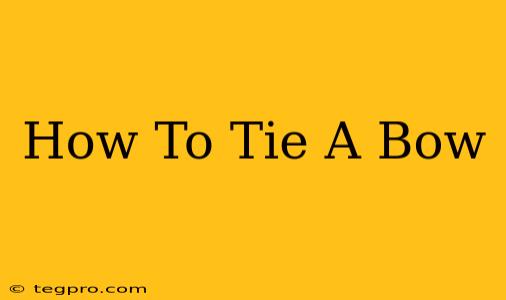Tying a bow might seem simple, but achieving that perfectly symmetrical, elegant knot can be trickier than it looks. Whether you're wrapping presents, crafting, or perfecting your shoelace game, mastering the art of bow-tying opens a world of possibilities. This comprehensive guide will walk you through various methods, ensuring you can tie a bow with confidence and precision every single time.
Different Types of Bows and Their Uses
Before diving into the techniques, let's explore the different types of bows you might encounter:
1. The Classic Bow
This is the quintessential bow, the one you likely imagine when you think of "tying a bow." It's versatile, suitable for gifts, hair accessories, and even crafting projects. We'll cover this method in detail below.
2. The Overhand Bow (or Simple Bow)
A quicker, less formal bow, ideal for everyday uses like shoelaces or quickly wrapping a small package.
3. The Double Bow
Adding a layer of complexity, this bow creates a fuller, more luxurious look, often seen on elaborate gifts or hair ribbons.
How to Tie a Classic Bow: A Step-by-Step Tutorial
This tutorial focuses on tying the classic, symmetrical bow. We'll use simple, clear instructions and images (if you were to include them in a blog post format) to guide you.
Step 1: The Cross
Hold the ribbon or string in both hands. Cross the right end over the left, forming an "X."
Step 2: The Loop
Make a loop with the right end of the ribbon, keeping your fingers tight to hold the loop’s shape.
Step 3: The Wrap
Take the left end of the ribbon and wrap it around and under the loop you just created.
Step 4: The Second Loop
Make a second loop with the left end of the ribbon, mirroring the first loop.
Step 5: The Tuck
Carefully tuck the left end of the ribbon under and through the space between the right loop and the base where the ribbon crosses.
Step 6: Tighten and Adjust
Gently tighten the bow by pulling both loops evenly. Adjust the loops to achieve a symmetrical and pleasing look.
Tips for Tying the Perfect Bow
- Ribbon Choice: Thicker ribbons are easier to work with for beginners. Experiment with different widths and materials to see what you prefer.
- Practice Makes Perfect: Don't get discouraged if your first few attempts aren't perfect. Keep practicing, and you'll quickly improve your technique.
- Even Loops: Aim for loops of equal size for a balanced and aesthetically pleasing bow.
- Symmetry: Take your time and adjust the loops until they are symmetrical.
Beyond the Basics: Variations and Creative Uses
Once you've mastered the classic bow, experiment with different ribbon types, colors, and textures to personalize your creations. Consider adding embellishments like beads or glitter for a touch of extra flair. You can even use the basic bow-tying technique to create unique bows for gift wrapping, hair accessories, or even scrapbooking projects. The possibilities are endless!
Keywords: tie a bow, how to tie a bow, bow tying tutorial, perfect bow, ribbon bow, gift wrapping, crafting, shoelaces, double bow, overhand bow, classic bow, easy bow, step by step, tutorial, guide.

